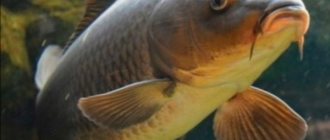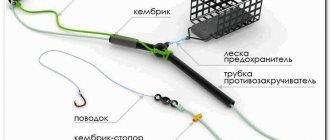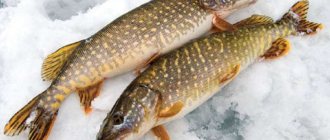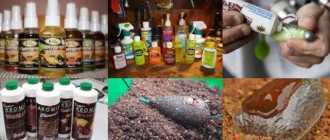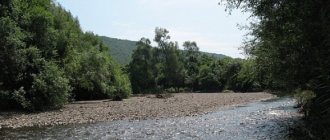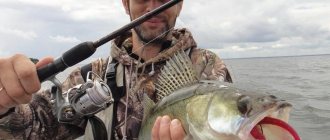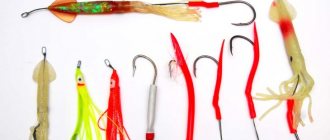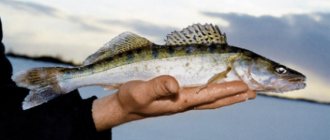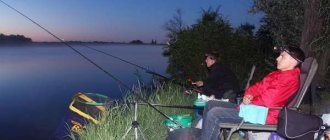A weighty carp is an excellent trophy that every fisherman will be happy with. Usually, in search of this fish, relatively clean and deep-water areas are fished, but reed thickets are no less promising places.
The reasons for this are the following:
- In the reeds it is easy for carp to hide from predators or sweltering heat;
- In water areas with rich aquatic vegetation, as a rule, there is an extensive food supply for fish: various mollusks, larvae, insects, food of plant origin.
- Water in overgrown areas with significant depth is rich in oxygen.
Fishing for carp in the reeds requires special preparation: you need to select gear suitable for the conditions, find or prepare “windows” yourself, and also get the hang of throwing the bait in such a way as not to spook the wary fish. It is these nuances that we will talk about in this article.
Selecting and preparing a fishing spot
Having found a water area with reeds, you should first examine it for the presence of natural “windows”. Clearings, the size of which reaches at least 1 m², can serve as such.
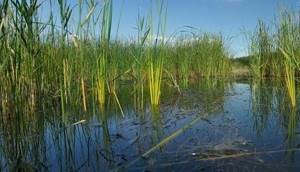
If such places do not exist, you can create them yourself. Using a knife, you first need to carefully cut the reed stems so that their height above the water is only a few centimeters.
The 1-1.5 m circle itself is cleared more thoroughly. In addition, for better convenience of the upcoming fishing, it is advisable to make a narrow path through which you can safely pull the fish.
You can often come across “windows” that have already been prepared by someone, but it is better to ignore them: it is unknown when and in what quantity bait was applied there, and whether a dissatisfied “owner” will appear half an hour later.
Features of carp fishing in the coastal reeds!
Have you ever observed how, near the shore, in the thickets of coastal reeds, not loud, but distinct “smacking” sounds are heard, and the reed stems themselves are slightly swaying? No? It means you simply weren’t paying attention, since this phenomenon occurs very often. And its meaning is as follows: now, near the shore, in those very reeds, there are about ten large carp, and there they feast on algae shoots, found worms, larvae, and other living creatures that abound in this place. Have you tried to catch him there? Maybe they tried, but did they succeed? Hardly. I tried to do this many times too. And quite unsuccessfully. As soon as I lowered the hook into the water, the carp instantly rushed in different directions. This is how their sizes became known to me. And believe me, this is far from a small thing.
This picture is especially common for private ponds, where the main population consists of crucian carp, carp, and grass carp with silver carp. But you can observe such a picture in any other pond or lake where carp and crucian carp live. Most often, carps abuse this behavior, less often they are joined by grass carp, silver carp and crucian carp, all to the same extent. But the main thing is the size of the fish. Do you think that these are undersized crucian carp tugging at the algae? I thought so too, until I accidentally dropped the sinker while casting into the coastal thickets. What came out there?! These were carps, large carps were feeding close to the shore! But it is useless to try to catch them with an ordinary fishing rod; I have already done this. This requires a special approach, and believe me, it’s worth going for such instances.
On hot, sultry summer days, carp and crucian carp often visit the coastal thickets, where they feed on all kinds of “carrion” - larvae, worms, fallen insects. And often such a picture means that fishing will be unsuccessful. In hot weather, the fish tends to the thickets, in the shade of which it finds both food and coolness. Therefore, if you managed to notice feeding carp in the bushes, this picture is probably not unique, and the carps also gathered near other coastal thickets of the reservoir. How to catch them?
First of all, you should not try to catch carp from the shore. Even “stupid” home-grown carp, raised in farm ponds, have excellent vision and hearing. They see and hear the fisherman perfectly, and as long as you are at a safe distance for them, they will not move. As a rule, they allow the angler to approach them, but as soon as the slightest extraneous noise is created, they will rush in all directions. Therefore, in this, as in any other carp fishing, caution and secrecy come first.
First you need to calm down and come to terms with the idea that you won’t catch them that day. And start preparing as early as possible. Oddly enough, you will have to fish from a boat, standing 10 meters from the carp feeding area. Now we need to clear the thickets of reeds so that free square windows, approximately one meter by meter in size, are formed in them. This can be done using an ordinary braid. You need a lot of windows, at least 10. Windows are made in the reeds at a depth of 1 meter, cutting the reeds at the root. After this we return home.
Now you need to build gear for such fishing. You will need a good carp fishing rod, definitely durable and at the same time comfortable. In this case, the tip of the rod should become a good bite indicator. We attach a piece of elastic rubber tube to the tip and thread a braided line through it. At the end of the line there is a dark, high-quality hook, in front of which we attach two pellets, and we go to bed.
The next day, preferably early in the morning, we sail a boat to the windows that were cut not long ago and put bait on their bottom. As bait you can use makha, boiled potatoes, millet porridge and other carp baits. I once read a similar article in a magazine, which described similar fishing for crucian carp, and they recommended using the following recipe as bait: boiled potatoes with millet plus steamed peas. I recommend her too. Also a very good bait.
Fishing should begin at the time when the carp usually comes out to feed. As a rule, this happens in the early morning, midday and early evening hours; after 17.00 I did not notice such exits to the coastal reeds.
During his closest approach to the reeds, from the opposite bank we carefully swim up to our windows, and as quietly as possible, without unnecessary noise, we lower the baited hook into the window. The rubber tube at the tip of the rod should hang down under the weight of the bait. And then begins why I love this kind of fishing. No shaking of the float, no “savoring” of the bait by the fish. Here the carp bites sharply, confidently, and pulls the line hard. And at this moment of tension in the fishing line, it is necessary to make a sharp hook. As a rule, after a short struggle, the fish ends up in the cage.
Unfortunately, after the first carp is caught, you need to change the place - after your fight with the fish, the carps probably hastened to get away from this place to hell. But there is no need to be upset. We swim to the next window and repeat the procedure. Having caught the carp, we change the place again and move to a new window. Now you understand why so many windows are needed. You can catch only one carp in each window, and carps, as a rule, do not approach every window.
I consider red dung worms to be the best bait for reed fishing for carp. No matter how much I fished with them, they always gave a 100% result. I would put mastyrka in second place. In general, there was also a bite for mastyrka in every carp window, but the fish were caught worse, and several offensive gatherings remain in my memory. I advise you to use steamed peas, potatoes, boilies and other baits only if the first two are unavailable. I was lucky to catch carp not always and not everywhere with these baits; the carp often simply ignored them. And the number of bites significantly exceeded the number of trophies. The carp masterfully knocks steamed peas and boiled potatoes off the hook. But, oddly enough, I consider boilies to be the worst bait for reed fishing for carp (but the best for catching them with a spinning rod). These dense balls emit a surprisingly loud “gurgling” sound when splashed down, and delivering them under the reeds quietly and unnoticed is very difficult.
The sizes of carp, as a rule, range from 700g to 2.5kg and above. Most often I came across 1-2 kg carp in the reeds. And carp weighing less than 1 kg are rather an exception to the rule. During my 2 years of experience in this kind of fishing, I caught 700-800 gram carp only three times. But many more large carp were caught.
Tackle for catching carp in the reeds
Fishing in areas with an abundance of reeds involves the use of a float rod, since it is unlikely that it will be possible to fish comfortably and effectively in such conditions with other gear.
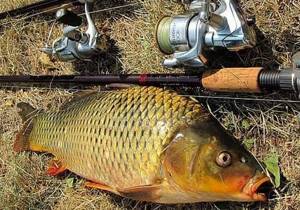
You will need a light rod with guide rings, 4-5 m long. It must be equipped with a small spinning reel with a spool size of 2000-2500.
For the main fishing line, a monofilament thread with a thickness of 0.25-0.3 mm and a breaking load of 3-6 kg is suitable. The leash should be thinner, and its length should be within 15-30 cm.
It is optimal to use several lead pellets as sinkers, which are not fixed at one point, but are evenly distributed throughout the equipment. You will also need a sliding float weighing about 3-4 g, with a thin and long antenna. The last element of the equipment is a strong and sharp hook No. 8-10.
Feeder
Spring crucian carp on the pond. The author of the popular blog Dmitry Salapin tells how to catch trophy crucian carp. How to assemble a fishing rod, select bait and feed the future fishing point, about baits and attachments and the fishing process itself.
Feeder fishing in spring. Alexey Fadeev, world champion in feeder fishing, about spring fishing for crucian carp on a feeder. A must watch.
Technological fishing for crucian carp on a pond. How to set up a fishing spot, mixing bait, choosing bait and the process of fishing in a small standing body of water.
Passive feeder. For a little variety, I’ll add a video for fans of bells on the tip of a feeder rod. Of course, this is not the best attribute for the sportiness and activity of the tackle, which is the feeder. Nevertheless, there are those who like to sit near the rod with the bell. For such connoisseurs, a story about fishing for large crucian carp.
Fishing for fun. Is a zakidushka a feeder tackle? What is the difference from a sports feeder and is this gear effective when fishing on a large body of water? In the video there is the use of a “crucian carp killer” rig, which is not sporting, but is quite catchy when used correctly.
On the muddy bottom. Feeder fishing in a reservoir with deep silt. What will be the key difficulty in catching crucian carp on such a reservoir using feeder gear, how to choose feeder equipment when any sinker and feeders are immersed in silt at least 10 cm.
Pickerel fishing technique. A picker is a light feeder, a tackle designed for fishing with light feeder weights and subsequently sinkers. Fishing takes place in still water, the process of baiting and baiting with different types of baits and attachments is shown.
Popular video about newbie mistakes. What are the main mistakes of novice feeders? What to do to avoid them. We will talk about the wrong choice of fishing rod, gear, fishing spot and analyzing your own mistakes in practice.
Crucian carp on the current. Don’t be surprised, but this peaceful white fish is popular not only in stagnant bodies of water, but also in rivers with strong currents. Most often in such places it can be caught in the spring. The video describes and shows the process of catching river crucian carp.
Underwater photography of feeders. How the crucian carp behaves when approaching the feeder feeder, how the biting process occurs - in a visual video from underwater filming while crucian carp fishing.
Carp baits and bait
To catch carp in the reeds, the usual baits of both animal and plant origin are used. Among these, it is worth highlighting boiled corn, peas and potatoes, dung worms, maggots, and boilies with different flavors.

If the thickets of reeds stretch for tens or even hundreds of meters, it is worth taking care of bait. The bait mixture should not be too viscous and low in calories, because its purpose is to lure the fish, and not to feed it before fishing. Ingredients can include boiled potatoes, millet, peas, crushed seeds, and milk powder. The addition of a small amount of vanilla or essential oils is welcome.
Features of carp fishing in the reeds
In the conditions that this type of fishing requires, casting the equipment most often involves delicately and accurately lowering the bait to the desired point, in this case, to the “window” in the middle of the reed thickets.
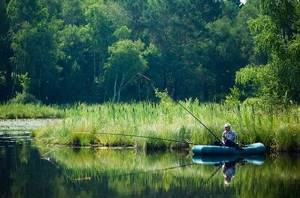
The line is wound along the length of about half the rod, and the float is lowered as close as possible to the hook. Once in a cleared clearing, you need to release the reel, thereby allowing the bait to sink to the bottom due to the weight of the installed weights.
As a rule, in the reeds, the carp grabs the hook with the nozzle sharply and strongly, so you need to carefully monitor the float and make the hook in time. To reduce the likelihood of an unfortunate loss of catch in the reeds, you should take a strong landing net with a long handle with you when fishing.
Author of the article: Vitaly Leonidovich Ivanov, 2021.
